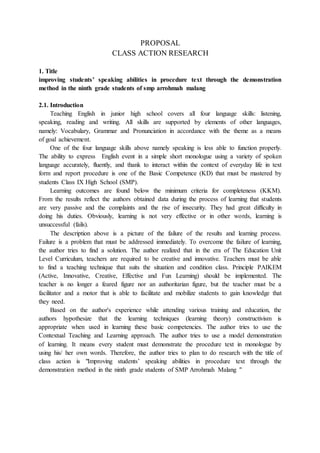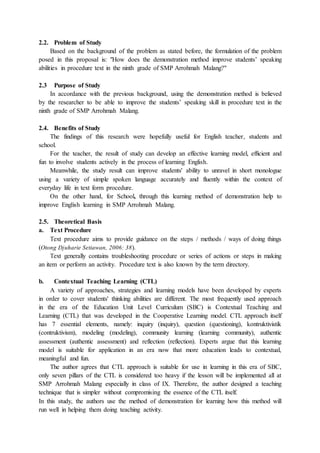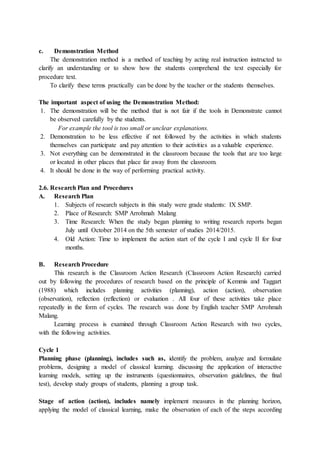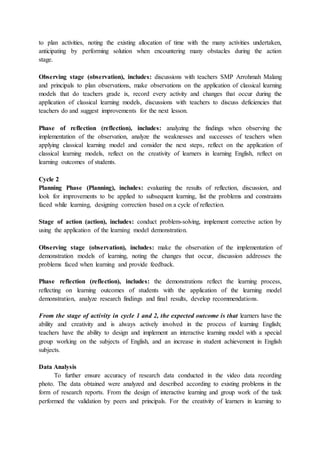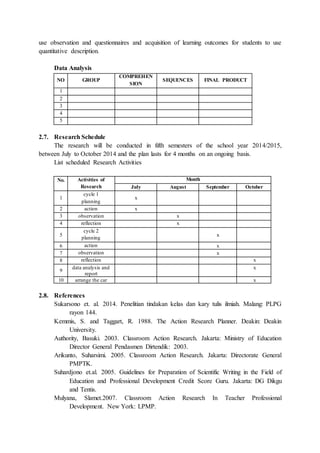Contoh proposal utk plpg di batu
- 1. PROPOSAL CLASS ACTION RESEARCH 1. Title improving students’ speaking abilities in procedure text through the demonstration method in the ninth grade students of smp arrohmah malang 2.1. Introduction Teaching English in junior high school covers all four language skills: listening, speaking, reading and writing. All skills are supported by elements of other languages, namely: Vocabulary, Grammar and Pronunciation in accordance with the theme as a means of goal achievement. One of the four language skills above namely speaking is less able to function properly. The ability to express English event in a simple short monologue using a variety of spoken language accurately, fluently, and thank to interact within the context of everyday life in text form and report procedure is one of the Basic Competence (KD) that must be mastered by students Class IX High School (SMP). Learning outcomes are found below the minimum criteria for completeness (KKM). From the results reflect the authors obtained data during the process of learning that students are very passive and the complaints and the rise of insecurity. They had great difficulty in doing his duties. Obviously, learning is not very effective or in other words, learning is unsuccessful (fails). The description above is a picture of the failure of the results and learning process. Failure is a problem that must be addressed immediately. To overcome the failure of learning, the author tries to find a solution. The author realized that in the era of The Education Unit Level Curriculum, teachers are required to be creative and innovative. Teachers must be able to find a teaching technique that suits the situation and condition class. Principle PAIKEM (Active, Innovative, Creative, Effective and Fun Learning) should be implemented. The teacher is no longer a feared figure nor an authoritarian figure, but the teacher must be a facilitator and a motor that is able to facilitate and mobilize students to gain knowledge that they need. Based on the author's experience while attending various training and education, the authors hypothesize that the learning techniques (learning theory) constructivism is appropriate when used in learning these basic competencies. The author tries to use the Contextual Teaching and Learning approach. The author tries to use a model demonstration of learning. It means every student must demonstrate the procedure text in monologue by using his/ her own words. Therefore, the author tries to plan to do research with the title of class action is "Improving students’ speaking abilities in procedure text through the demonstration method in the ninth grade students of SMP Arrohmah Malang "
- 2. 2.2. Problem of Study Based on the background of the problem as stated before, the formulation of the problem posed in this proposal is: "How does the demonstration method improve students’ speaking abilities in procedure text in the ninth grade of SMP Arrohmah Malang?" 2.3 Purpose of Study In accordance with the previous background, using the demonstration method is believed by the researcher to be able to improve the students’ speaking skill in procedure text in the ninth grade of SMP Arrohmah Malang. 2.4. Benefits of Study The findings of this research were hopefully useful for English teacher, students and school. For the teacher, the result of study can develop an effective learning model, efficient and fun to involve students actively in the process of learning English. Meanwhile, the study result can improve students' ability to unravel in short monologue using a variety of simple spoken language accurately and fluently within the context of everyday life in text form procedure. On the other hand, for School, through this learning method of demonstration help to improve English learning in SMP Arrohmah Malang. 2.5. Theoretical Basis a. Text Procedure Text procedure aims to provide guidance on the steps / methods / ways of doing things (Otong Djuharie Setiawan, 2006: 38). Text generally contains troubleshooting procedure or series of actions or steps in making an item or perform an activity. Procedure text is also known by the term directory. b. Contextual Teaching Learning (CTL) A variety of approaches, strategies and learning models have been developed by experts in order to cover students' thinking abilities are different. The most frequently used approach in the era of the Education Unit Level Curriculum (SBC) is Contextual Teaching and Learning (CTL) that was developed in the Cooperative Learning model. CTL approach itself has 7 essential elements, namely: inquiry (inquiry), question (questioning), kontruktivistik (contruktivism), modeling (modeling), community learning (learning community), authentic assessment (authentic assessment) and reflection (reflection). Experts argue that this learning model is suitable for application in an era now that more education leads to contextual, meaningful and fun. The author agrees that CTL approach is suitable for use in learning in this era of SBC, only seven pillars of the CTL is considered too heavy if the lesson will be implemented all at SMP Arrohmah Malang especially in class of IX. Therefore, the author designed a teaching technique that is simpler without compromising the essence of the CTL itself. In this study, the authors use the method of demonstration for learning how this method will run well in helping them doing teaching activity.
- 3. c. Demonstration Method The demonstration method is a method of teaching by acting real instruction instructed to clarify an understanding or to show how the students comprehend the text especially for procedure text. To clarify these terms practically can be done by the teacher or the students themselves. The important aspect of using the Demonstration Method: 1. The demonstration will be the method that is not fair if the tools in Demonstrate cannot be observed carefully by the students. For example the tool is too small or unclear explanations. 2. Demonstration to be less effective if not followed by the activities in which students themselves can participate and pay attention to their activities as a valuable experience. 3. Not everything can be demonstrated in the classroom because the tools that are too large or located in other places that place far away from the classroom. 4. It should be done in the way of performing practical activity. 2.6. Research Plan and Procedures A. Research Plan 1. Subjects of research subjects in this study were grade students: IX SMP. 2. Place of Research: SMP Arrohmah Malang 3. Time Research: When the study began planning to writing research reports began July until October 2014 on the 5th semester of studies 2014/2015. 4. Old Action: Time to implement the action start of the cycle I and cycle II for four months. B. Research Procedure This research is the Classroom Action Research (Classroom Action Research) carried out by following the procedures of research based on the principle of Kemmis and Taggart (1988) which includes planning activities (planning), action (action), observation (observation), reflection (reflection) or evaluation . All four of these activities take place repeatedly in the form of cycles. The research was done by English teacher SMP Arrohmah Malang. Learning process is examined through Classroom Action Research with two cycles, with the following activities. Cycle 1 Planning phase (planning), includes such as, identify the problem, analyze and formulate problems, designing a model of classical learning. discussing the application of interactive learning models, setting up the instruments (questionnaires, observation guidelines, the final test), develop study groups of students, planning a group task. Stage of action (action), includes namely implement measures in the planning horizon, applying the model of classical learning, make the observation of each of the steps according
- 4. to plan activities, noting the existing allocation of time with the many activities undertaken, anticipating by performing solution when encountering many obstacles during the action stage. Observing stage (observation), includes: discussions with teachers SMP Arrohmah Malang and principals to plan observations, make observations on the application of classical learning models that do teachers grade ix, record every activity and changes that occur during the application of classical learning models, discussions with teachers to discuss deficiencies that teachers do and suggest improvements for the next lesson. Phase of reflection (reflection), includes: analyzing the findings when observing the implementation of the observation, analyze the weaknesses and successes of teachers when applying classical learning model and consider the next steps, reflect on the application of classical learning models, reflect on the creativity of learners in learning English, reflect on learning outcomes of students. Cycle 2 Planning Phase (Planning), includes: evaluating the results of reflection, discussion, and look for improvements to be applied to subsequent learning, list the problems and constraints faced while learning, designing correction based on a cycle of reflection. Stage of action (action), includes: conduct problem-solving, implement corrective action by using the application of the learning model demonstration. Observing stage (observation), includes: make the observation of the implementation of demonstration models of learning, noting the changes that occur, discussion addresses the problems faced when learning and provide feedback. Phase reflection (reflection), includes: the demonstrations reflect the learning process, reflecting on learning outcomes of students with the application of the learning model demonstration, analyze research findings and final results, develop recommendations. From the stage of activity in cycle 1 and 2, the expected outcome is that learners have the ability and creativity and is always actively involved in the process of learning English; teachers have the ability to design and implement an interactive learning model with a special group working on the subjects of English, and an increase in student achievement in English subjects. Data Analysis To further ensure accuracy of research data conducted in the video data recording photo. The data obtained were analyzed and described according to existing problems in the form of research reports. From the design of interactive learning and group work of the task performed the validation by peers and principals. For the creativity of learners in learning to
- 5. use observation and questionnaires and acquisition of learning outcomes for students to use quantitative description. Data Analysis NO GROUP COMPREHEN SION SEQUENCES FINAL PRODUCT 1 2 3 4 5 2.7. Research Schedule The research will be conducted in fifth semesters of the school year 2014/2015, between July to October 2014 and the plan lasts for 4 months on an ongoing basis. List scheduled Research Activities No. Activities of Research Month July August September October 1 cycle 1 planning x 2 action x 3 observation x 4 reflection x 5 cycle 2 planning x 6 action x 7 observation x 8 reflection x 9 data analysis and report x 10 arrange the car x 2.8. References Sukarsono et. al. 2014. Penelitian tindakan kelas dan kary tulis ilmiah. Malang: PLPG rayon 144. Kemmis, S. and Taggart, R. 1988. The Action Research Planner. Deakin: Deakin University. Authority, Basuki. 2003. Classroom Action Research. Jakarta: Ministry of Education Director General Pendasmen Dirtendik: 2003. Arikunto, Suharsimi. 2005. Classroom Action Research. Jakarta: Directorate General PMPTK. Suhardjono et.al. 2005. Guidelines for Preparation of Scientific Writing in the Field of Education and Professional Development Credit Score Guru. Jakarta: DG Dikgu and Tentis. Mulyana, Slamet.2007. Classroom Action Research In Teacher Professional Development. New York: LPMP.

